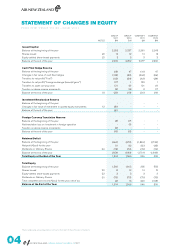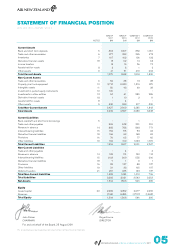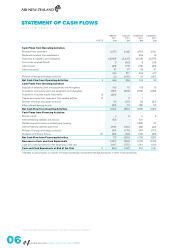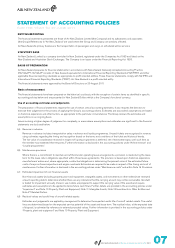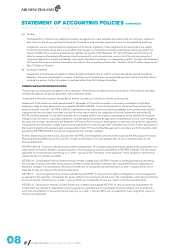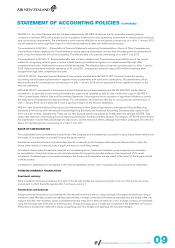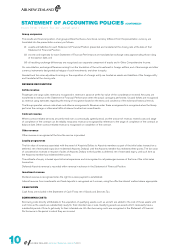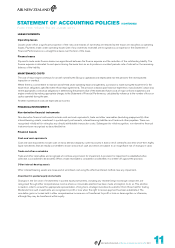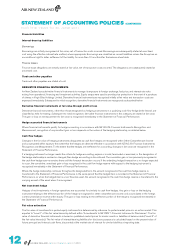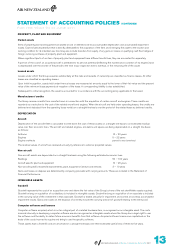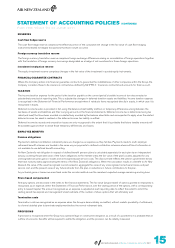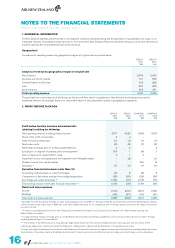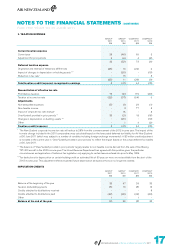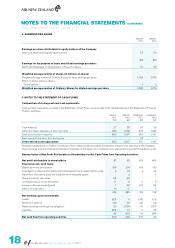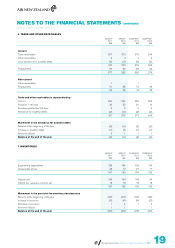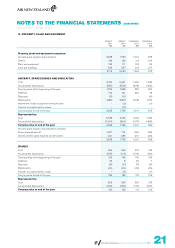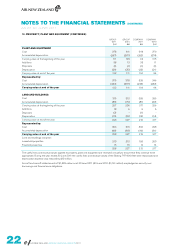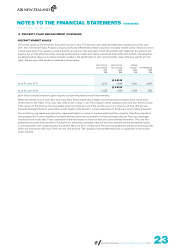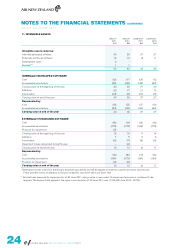Air New Zealand 2011 Annual Report Download - page 16
Download and view the complete annual report
Please find page 16 of the 2011 Air New Zealand annual report below. You can navigate through the pages in the report by either clicking on the pages listed below, or by using the keyword search tool below to find specific information within the annual report.
Expenditure on research activities is recognised as an expense in the period in which it is incurred.
Development costs
Expenditure related to development costs which is applied to external customer products and services is recognised as an asset and
stated at cost. The asset is amortised on a straight line basis over the period of the expected benefits. All other development costs are
recognised in the Statement of Financial Performance as incurred.
IMPAIRMENT
Impairment of financial assets at amortised cost
Financial assets carried at amortised cost are assessed each reporting date for impairment. If there is objective evidence of impairment,
the difference between the asset’s carrying amount and the present value of estimated future cash flows, discounted at the financial
asset’s original effective interest rate, where appropriate, is recognised in the Statement of Financial Performance.
Impairment of non-financial assets
Non-financial assets are reviewed at each reporting date to determine whether there are any indicators that the carrying amount may
not be recoverable. If any such indicators exist, the asset’s recoverable amount is estimated. The recoverable amount is the higher of an
asset’s fair value less costs to sell and value in use. In assessing value in use, the estimated future cash flows are discounted to their
present value using a discount rate that reflects current market assessments of the time value of money and the risks specific to the
asset. An impairment loss is recognised in the Statement of Financial Performance for the amount by which the asset’s carrying amount
exceeds its recoverable amount. For the purposes of assessing impairment, assets are grouped at the lowest level for which there are
separately identifiable cash flows (cash-generating units).
Aircraft are operated by the airline as a single network and are assessed for impairment as one cash-generating unit, inclusive of
related infrastructural assets. Estimated net cash flows used in determining recoverable amounts are based on the directors’ current
assessment of the Group’s future trading prospects and the assets’ ultimate net sale proceeds and have been discounted to their net
present value. Aircraft which have been withdrawn from service and have no intention of being reintroduced into the operating fleet are
assessed for impairment on an individual basis.
Where an impairment loss subsequently reverses, the carrying amount of the asset or cash-generating unit is increased to the revised
estimate of its recoverable amount, but so that the increased carrying amount does not exceed the carrying amount that would have
been determined had no impairment loss been recognised in prior years.
ASSETS HELD FOR RESALE
Non-current assets are classified as held for resale if their carrying amount will be recovered through a sale transaction rather
than through continuing use. The sale must be highly probable and the asset available for immediate sale in its present condition.
Management must be committed to the sale, which should be expected to qualify for recognition as a completed sale within one year
from the date of classification.
Non-current assets classified as held for resale are measured at the lower of the asset’s previous carrying amount and its fair value less
costs to sell.
WORK IN PROGRESS
Contract work in progress is stated at cost plus the profit recognised to date, using the percentage of completion method, less any
amounts invoiced to customers. Cost includes all expenses directly related to specific contracts and an allocation of direct production
overhead expenses incurred.
Capital work in progress includes the cost of materials, services, labour and direct production overheads.
INVENTORIES
Inventories are measured at the lower of cost and net realisable value. Cost is determined using the first-in, first-out (FIFO) cost method.
Net realisable value is the estimated selling price in the ordinary course of business, less applicable variable selling expenses.
SHARE CAPITAL
Ordinary shares are classified as equity. Incremental costs directly attributable to the issue of new shares or options are shown in equity
as a deduction, net of taxation, from the proceeds.
Where a member of the Group purchases the Company’s share capital, the consideration paid is deducted from equity under the
treasury stock method, until they are reissued or otherwise disposed of.
STATEMENT OF ACCOUNTING POLICIES (CONTINUED)
FOR THE YEAR TO 30 JUNE 2011
AIR NEW ZEALAND ANNUAL FINANCIAL RESULTS 2011


